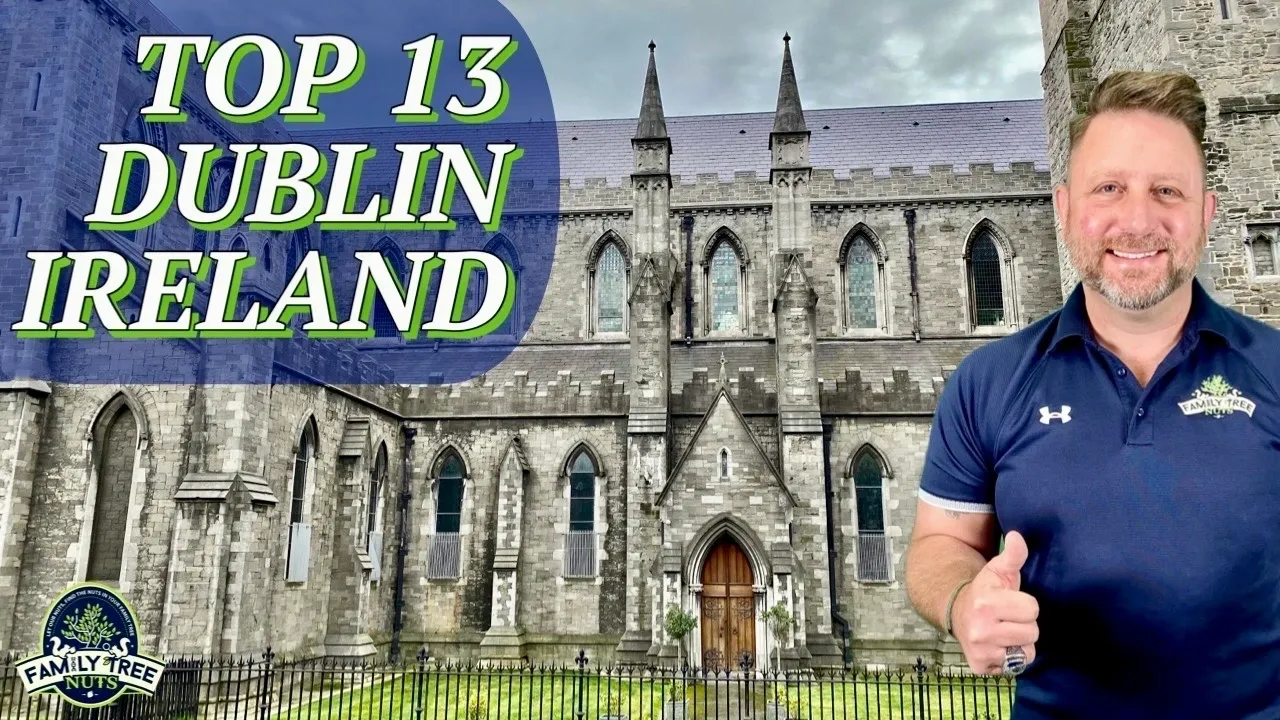
“LUCKY” TOP 13 HISTORY MUST SEES IN DUBLIN, IRELAND
The ancient city of Dublin, Ireland, the capital of the Emerald Isle and one of the favorite destinations for tourists all over the world. There have been people living here before recorded history and even the Romans wrote about a village here. The Vikings established it as an important port city where the Rivers Liffey and Poddle come together and its name in old Gaelic is Dubh Linn, meaning “Dark Pool”. The Irish tribes took back control of the area in the year 988, and that is the date accepted as the birth of Dublin, an entire millennium ago. Its history has been an extremely complicated, full of turmoil, between Catholics and Protestants. It’s often been very hard to determine who was friend of foe or which side someone was on. The city has produced literary giants and products that are well known around the world. It’s certainly hard to sum up the city in just a few words.
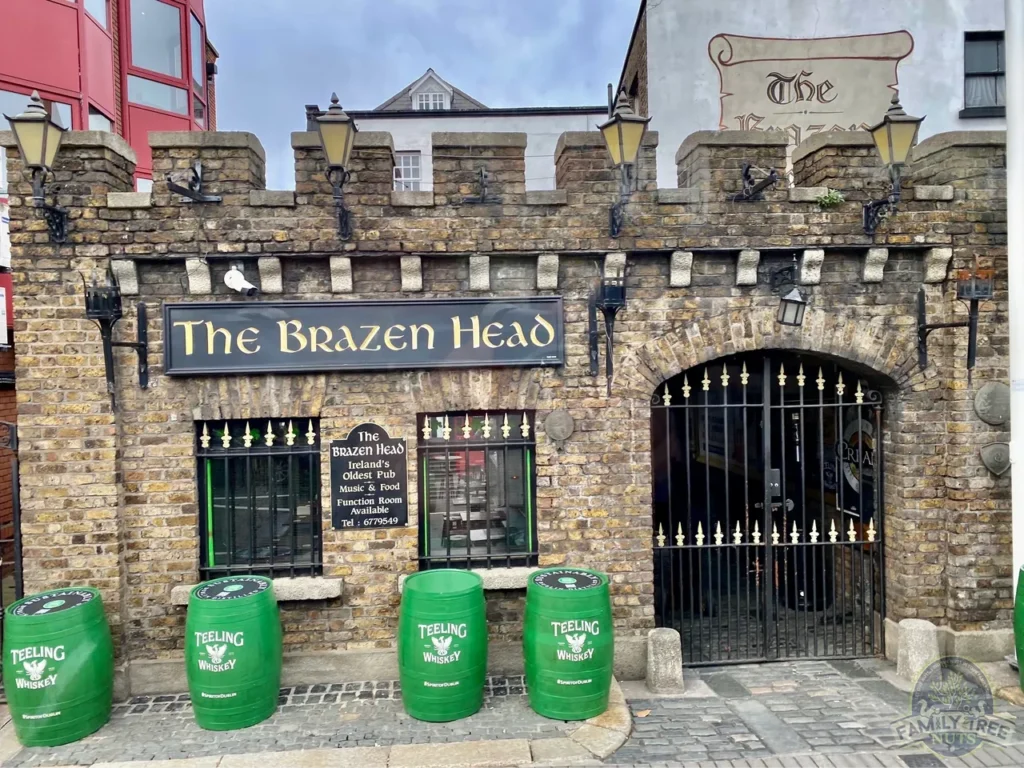
We recently visited Dublin, took in the sights and made this list. It should be mentioned that these sites are all historic places and modern highlights of Dublin have been left out. It should also be mentioned that this list could have been fifty or more but we tried to limit them to the absolute best. Why 13? Well, the Irish have always been associated with luck, even if many of them have never had any. The number 13 has always been associated with bad luck, but we are hoping that this list may change that a bit. Also, this is our list. We are a team of historians and genealogists and you may totally disagree with the way we have ranked them, so be sure to leave a comment below of how you would have changed these up a bit or tell us what we left out. This article is one of several that we have from Ireland, so be sure to check out our website at www.familytreenuts.org to see more. Ok, enough rambling, and on to the list!
13- The River Liffey
The River Liffey’s name in Gaelic literally means “an life” and that’s exactly what it has been to the city of Dublin throughout all history. The river runs about 82 miles in eastern Ireland and is fed by the Rivers Dodder, Poddle and Camac until it flows in Dublin Bay in the Irish Sea. Since Dublin’s founding, the river has been its source of drinking water and the supply for the hundreds of breweries and distilleries over the centuries. It also has been the most important shipping highway, not only to ships in the bay, but also around the city and upriver. As with all major cities, the river has often had issues with pollution, and has sometimes been referred to by the locals as, “The Sniffy Liffey” because of its foul odor. It should be mentioned that Dublin takes pride in the cleanliness of its important river. Today dozens of iconic bridges cross the river used by both vehicles and foot traffic and walking along and across this historically important river is definitely a must do for any visitor to Dublin.

12- Phoenix Park
It is said that Phoenix Park is where Dublin goes to breathe. The park is 1,750 acres large and was first set aside in the 1660s as a royal hunting park. The park still has a large herd of wild deer that call it home. It is also the home to several famous and important landmarks such as the Dublin Zoo, the United States Embassy, Ireland’s President’s Home, and the Magazine Fort. The park also proudly houses important monuments. The most notable is the Wellington Monument, which is a 203’ tall obelisk that commemorates the Duke of Wellington’s military victories, including his defeat of Napoleon Bonaparte at the Battle of Waterloo. This monument can be seen at many points around the city. Another important landmark in the park is the Papal Cross which is a 115’ high cross on top a mound surrounding and open 15 acres. The cross stands on the spot were Pope John Paul II conducted an open outdoor mass on September 29, 1979 for over one million people who had gathered. The park is open 24 hours a day and 365 days a year and is certainly a must see when you visit Dublin.
11- Dublin City Hall
This historic building was built in 1779 and served as the Royal Exchange. It began being used as City Hall in 1852, and remains in use today. What makes this site important enough to make this list is the action that took place here in the 1916 Easter Rising which was the beginning of what eventually lead to Irish Independence. A group of the Irish Citizen Army, otherwise known as the ICA, under the command of Captain Seán Connolly, attacked the British Government at Dublin Castle. The group shot and killed Dublin Metropolitan Police Officer James O’Brien and took the guard house, but were not able to take the whole facility and was forced to retreat back to City Hall. Upon fortifying the building, Captain Connolly was on the roof top when he was shot dead by a British sniper. He was the first rebel to die in the 1916 Easter Rising. A few hours later second-in-command Lieutenant Seán O’Reilly was killed by machine gun fire attempting to get off the roof through a skylight. Another of the ICA men to die that day was George Geoghegan, who was a British Army veteran of the Second Boer War in South Africa. George was shot in the head early in the fighting. The final man killed here was Louis Byrne who was one of the reinforcements sent to City Hall from the rebel headquarters at the General Post Office. Visiting the site of the first rebel killed in the 1916 Easter Rising is a quite sobering experience.
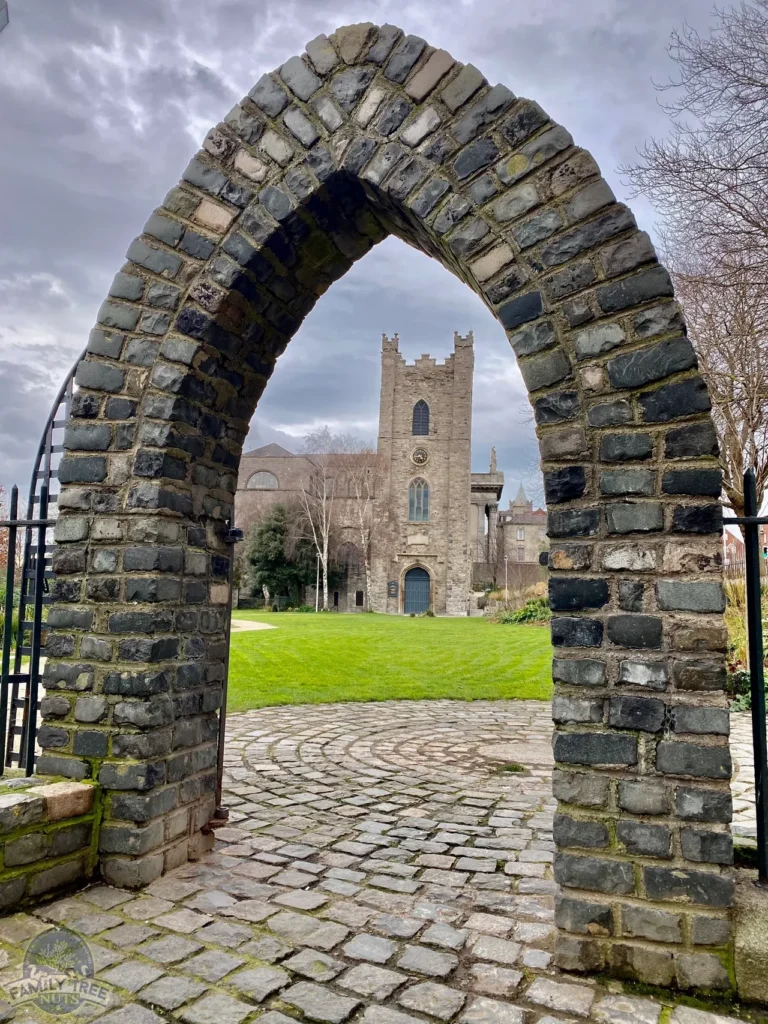
10- Dublin Castle
Dublin Castle has been called “the nerve center of historical power in Ireland”. A place of military defense has been on this site, since at least the time of the Vikings, over one thousand years ago. The castle began to be constructed in the year 1204, over eight hundred years ago, on the orders of King John of England, yes that King John, the brother of King Richard the Lionhearted and of Robin Hood Fame. He’s also the same King John who signed the Magna Carta, this castle is that old! The castle served as the seat of government for the Irish Viceroy, who was the representative of the ruling King of England, and later Great Britain, from 1204, until 1922, when control was turned over to an independent Republic of Ireland. The castle and courtyard held government buildings and its rooms and court yard have been used for elaborate balls and ceremonies. As mentioned above, the castle also played a large role in the 1916 Easter Rising. You may be surprised to hear what connections Dracula has in common with Dublin Castle. The author and creator of Dracula, Bram Stocker, worked as the Clerk of Inspection at Dublin Castle and his father worked there for fifty years. Finally, the castle was the scene of the 1907 theft of the valuable diamond Chains of Office of the Knights of Saint Patrick, sometimes called the “Irish Crown Jewels”. The crime has never been solved, and the jewels have never been found, so if you have Irish ancestors, it may be worth looking through grandma’s attic. Be sure to see our individual video from here!
9- The Temple Bar District
If you ask anyone what is one thing that comes to mind when they think of Irish culture and undoubtedly, one of the first things that will come to mind is an Irish pub. Dublin’s Temple Bar District is by far the premiere spot in the world to enjoy a pint, share in the craic, and take in some the wonderful songs of our heritage. The area was originally established in the early 1600s as a suburb outside the city walls, along the River Liffey. The area is thought to be named after Sir William Temple, who was once a leading advisor to King Charles II. Temple built a house and gardens in the area in the early 1600s. Today the area is home to dozens of iconic Irish pubs which are always packed, no matter the day or even the time of day. The world-famous Temple Bar was founded in 1840, and is the obvious anchor of the area, and a must visit when coming to Dublin. I’d also be amiss if I didn’t mention that the that there is a restaurant next to The Temple Bar called, “The Shack”, where we had the best fish and chips of our lives, no exaggeration. Don’t forget to try one of their “Baby Guinness’”. You shouldn’t be alarmed if the Temple Bar itself is too packed, there are plenty of places to find the perfect Irish environment that we all look for when coming to Ireland. The crowds are always cheerful and the moods are lively. When it’s time to finally head to bed, you can take in some beautiful lights on the River Liffey.
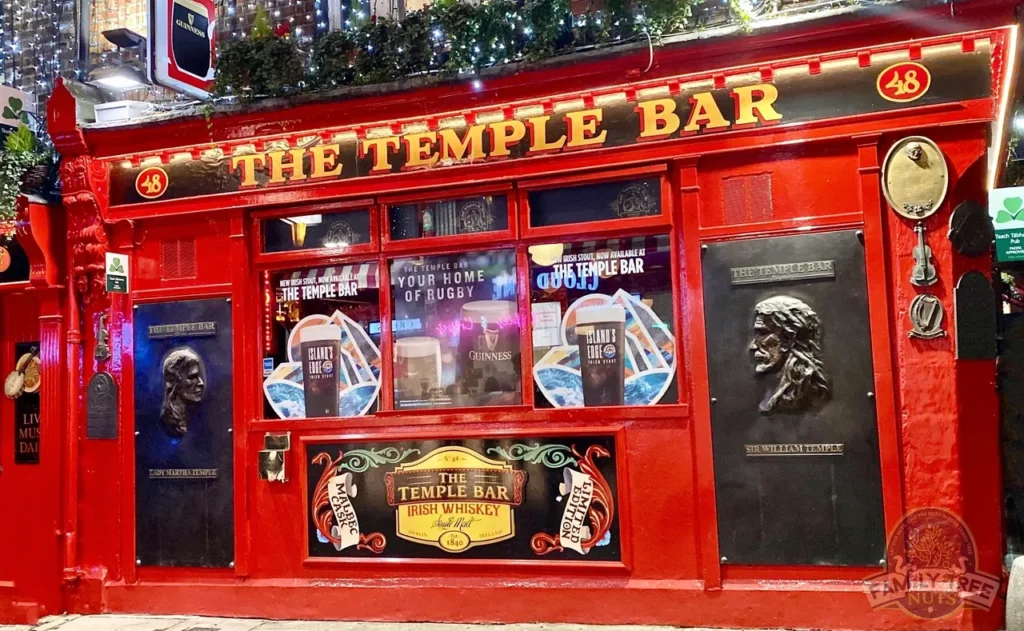
8- The Brazen Head
Since we are on the topic of Irish Pubs, one should not miss a chance to visit what is said to be the oldest pub in Ireland, The Brazen Head. It is hard to wrap our heads around it, but this pub was founded in the year 1198, that’s right, 1198! The pub sits on the small area where the original city of Dublin began. Just outside its door is the where the first bridge across the River Liffey once stood. The pub has served as a tavern and hotel over the centuries and the ambiance is hard to beat. The walls are decorated with Irish history and you can even leave something behind to say you were there. Be sure to grab you a t-shirt from here too, because if you are going to try to achieve your goal of attending all the pubs in Ireland, you may as well start with the oldest.
7- The Viking Arch
What is cooler than passing through a gate that was built by the Vikings? Just a stone’s throw away from the Brazen Head is St. Audoen’s Church, which was built in the year 1300. Outside of the church is a park and on the border of the park is the last remaining section of the city’s wall that is said to have been built around the year 1100. Here you will see the last remaining gate of the old city walls. Some say this arch is even older than the walls, and was standing here when Dublin was still controlled by Viking settlers making it the last thing standing that was built by the foreign invaders. Be sure to use your imagination of all the people through the centuries that passed right under this arch just like you can.
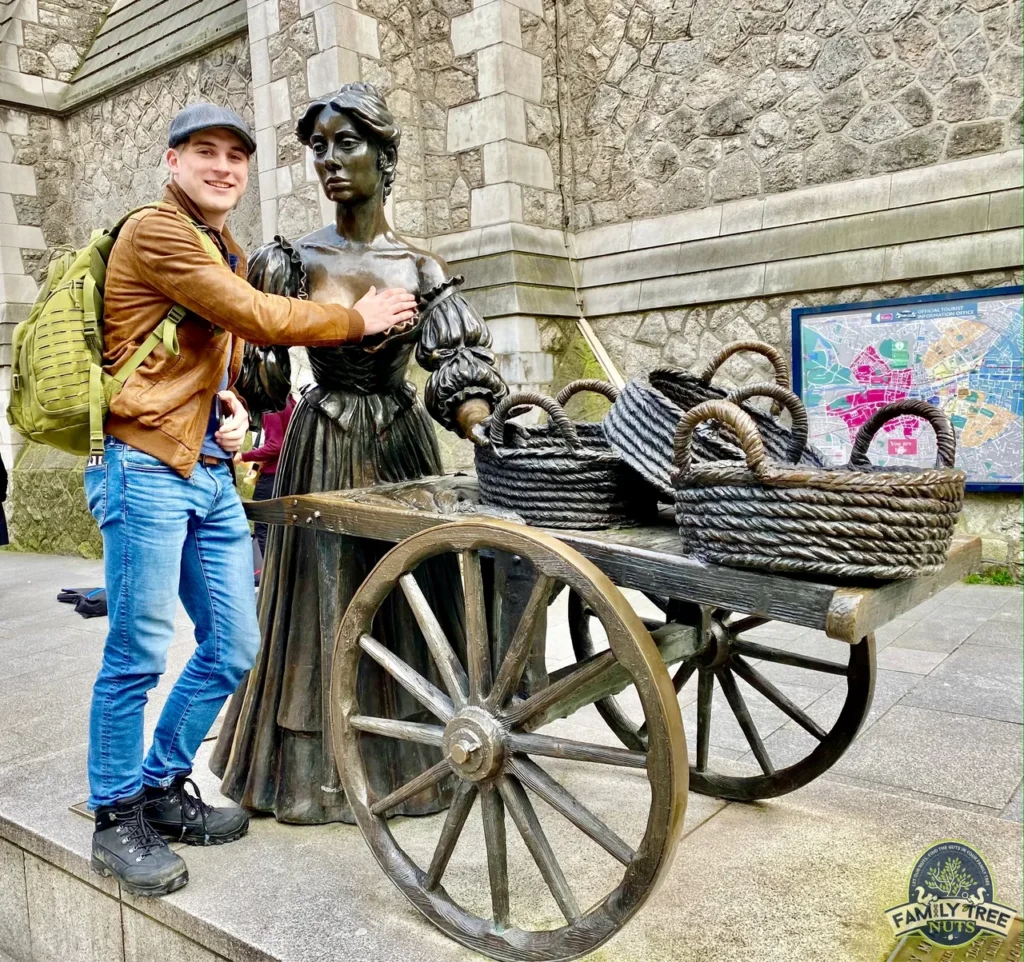
6- Molly Malone Statue
Anyone of Irish descent worth their salt is familiar with this song. “In Dublin’s fair city, where the girls are so pretty, I first set my eyes on sweet Molly Malone…” Sing along with me, just kidding, I know how awful I sound, but I’m too Irish to care. The Molly Malone Statue sits in front of the old Saint Andrew’s church which is now used as the Tourist Information Office. Some say Molly Malone is a fictional character and a representative of a group of women in Dublin, in the 1600s called “fishwives”. Fishwives were the wives or daughters of a fisherman. These women were said to be gruff, unpolished and foul mouthed. I think you are getting the picture and perhaps you are thinking of some women that you know today that fit that same description. Molly was a “hawker” or a “monger” which was someone who sold things from a cart on the streets. Hawkers and mongers of the time were often known to work a different trade on the streets at night, but our Molly is said to be one of the few that maintained her chastity and dignity. The legend says that Molly sadly died of a fever at a young age. While some maintain that Molly Malone is a symbolic character, others say that she was a real person. In fact, in the Dublin records there was found a woman named Molly Malone who died on June 13, 1699. There is no evidence that this particular Molly Malone is the one whom the song was written for, but in 1988, the year of the 1,000th anniversary of Dublin, June 13th was declared as, “Molly Malone Day”. The holiday has been celebrated in Dublin on each June 13th since. Perhaps you will now celebrate Molly Malone Day too. Supposedly it’s good luck to touch her left breast, or is it her right breast? Perhaps you should touch them both to be safe. Be sure to see our individual video from here!
5- Trinity College
Trinity College was founded in 1592 by Queen Elizabeth I, and until modern times was for protestants only. Trinity College is also referred to as The University of Dublin and was modeled after England’s Oxford and Cambridge Universities. Since its founding, Trinity has been at the center of Ireland’s history and politics and to this day, continues as one of the most elite universities in the world. The college is home to several items of Irish pride. One of those items is the Brian Boru Harp, which is the oldest surviving Irish harp, and the insignia of Ireland. It was once mistakenly linked with Brian Boru, high king of Ireland who was killed in 1014 at the Battle of Contarf, in modern day Dublin. Also, on display is one of the last remaining copies of the 1916 Proclamation of the Irish Republic. This copy was posted to the wall of the General Post Office at the start of the 1916 Easter Rising, which eventually lead to Ireland’s independence from Great Britain. Both the Brian Boru Harp and the 1916 Proclamation of the Irish Republic are on display in the Long Room. The Long Room which is also called, Trinity College’s Old Library building, was founded in 1732 and is in use to this day. The library is sixty-five meters long, making it the longest single room library in Europe. It houses over 200,000 of the college’s ancient books and over seven million pieces of printed materials. For obvious reasons it has been nicknamed, the “Harry Potter Library”. Be sure to see our individual video from here!

4- The Book of Kells
Although the Book of Kells is housed at Trinity College, its magnificence is deserving of its own spot on this count down. The Book of Kells was written around the year 800, and contains summaries of the Gospels of Jesus Christ and is written in Latin. It is ornately decorated with figures of Celtic knots, designs, humans, animals and mythical creatures. Its beauty has caused it to be called, “the work of angels”. Contained in the book are 340 leaves or folios in Latin, which are left-side and right-side pages of an open book. The Book of Kells has withstood dozens of invasions and conflicts by Vikings, and English Protestants, and has survived them all. There are a handful of books that have survived to this day that are similar to the Book of Kells but none of them so beautifully decorated. Trinity College has an excellent exhibit where you can learn all about this treasure and you can even see the book with your own eyes, but no photography is allowed. Today the Book of Kells is a symbol of national Irish pride and one of the countries most sacred historical objects. Be sure to see our individual video from here!
3- Jameson’s Bow Street Distillery
It is said that, God invented whiskey so the Irish would never rule the world. The word “whiskey” comes from a Gaelic word that means “water of life”, so it is easy to understand how perfect the words, Irish, and whiskey sound together. Jameson is by far the most popular Irish whiskey in the world and you won’t want to miss visiting the Bow Street Distillery. The site opened in 1780 and even though the product is no longer produced here, you learn all about the long and awesome history the company has had. The Jameson family not only oversaw the whiskey business but were also leaders in the community including being High Sheriff of County Dublin. Here you can take a tour that covers the history of Jameson, how it is produced and how the process evolved, and of course enjoy a sampling while learning about the different products that Jameson produces. Of course, at the end of your visit, you are welcome to visit the bar decorated with the emerald bottles. Be sure to see our individual video from here!
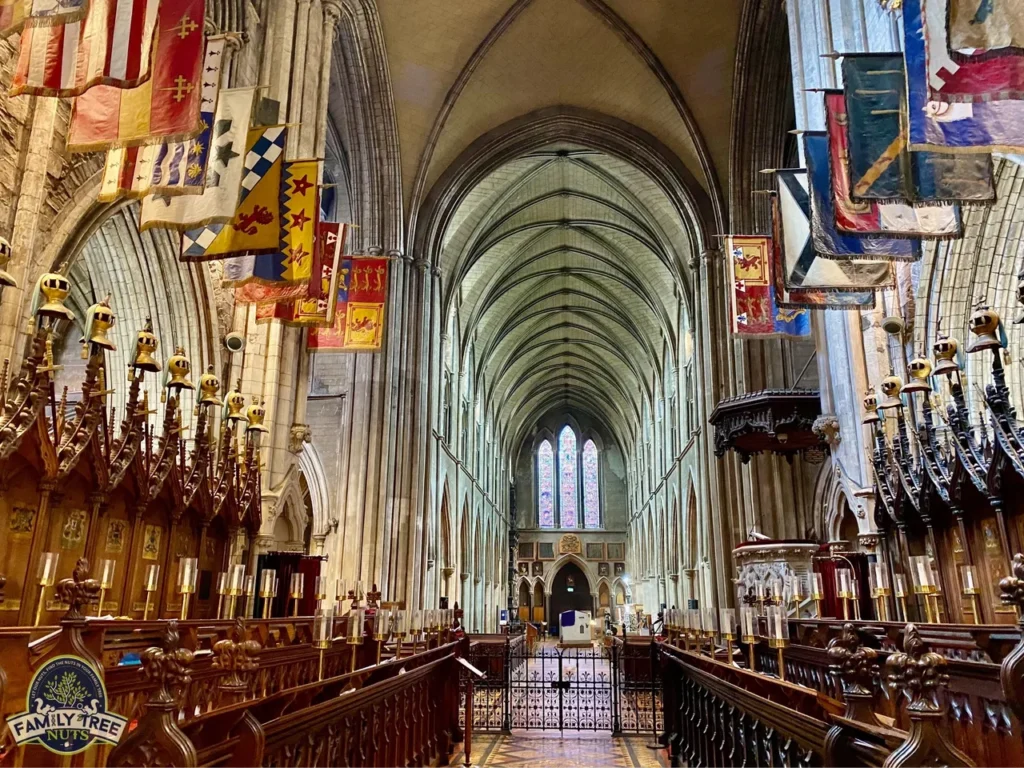
2- Guinness Storehouse at Saint James’ Distillery
If you ask anyone what is a product that is produced in Ireland, almost everyone will first mention Guinness. Even the companies trademark harp became the insignia of Ireland when it earned its independence in 1922. It is not only a staple of any Irish parade or festival all over the world, but also a staple of the Irish people as well. Guinness has been labeled as the number one beverage in Ireland and it would be hard to find even a small town where you couldn’t grab a pint in a matter of minutes. Guinness’ association with Ireland is why you definitely won’t want to miss visiting the Guinness Storehouse. Arthur Guinness rented this place in 1759, on a 9,000-year lease at 45 pounds a year and here it is today. When you visit the location, you can go on a self-guided tour to learn all about the company’s history, and how it is made. Guinness has always been famous for its advertising campaigns that involved catchy jingles such as, “My Goodness, My Guinness”, and humorous situations with animals and people. Here you can literally get your face drawn on the foam head of a pint! How cool is that!? At the end of the tour is one of the most popular spots in Dublin, the 360-degree gravity bar. Surrounded by glass, and seven stories high, you can see amazing views of the city. Historical information is on the glass about things you are looking at. Being able to see the city in such a way that once only the birds could, makes this stop is a must when visiting Dublin. Be sure to see our individual video from here!
1- Saint Patrick’s Cathedral
It is said that around the year 450 AD, over 1,500 years ago, Saint Patrick himself baptized Irish converts in a spring on this spot. This 800-year-old cathedral had been declared the National Cathedral of Ireland, and with just one visit, and a little understanding of its history, will leave you little doubt as to why. The first documented mention of a church here was in the year 1178 but it is believed that a church has been here long before then. Construction on the Cathedral began in 1220 and its history is full of important events from Irish history. It is estimated that between six to seven hundred souls are entombed inside or buried outside the cathedral. The walls are lined with monuments and statues of important people throughout Dublin’s history. One of the most unique things about the cathedral is above the choir stalls are the helmets, swords, and flags of The Knights of Saint Patrick. The cathedral was totally remodeled in the 1860s, with funding provided by Sir Benjamin Lee Guinness, the heir to the Guinness brewing empire. During that renovation the stained-glass windows were added as well as the medieval style floor tiles. Outside the cathedral is Saint Patrick’s Park, which holds the Literary Parade that was built in 1988, the 1,000th anniversary of the City of Dublin. Along the wall are the shrines of twelve literary giants from Dublin, each of them having had an impact on the world. Many say visiting this cathedral gives them the feeling of being in the presence of God Almighty and that alone makes it a place that you don’t want to miss out on visiting. Be sure to see our individual video from here!
So, there is our list, what do you think? What did we miss? Do you agree or not agree with how we ranked these places? Please be sure to comment below, we would love to hear what you think. Also, we have much more detailed articles about several of the places in this countdown, so be sure to look them up in our website.
We hope that you have enjoyed this article and we are proud to bring it to you. Dublin, Ireland is always high on the list of most people for places that they dream about visiting, and only a small percentage get that opportunity. Hopefully through this article we have given you a little insight on the history of the city, and in a sense taken you there. Until next time, Slainte Mhath! Be sure to see the video below from these locations.
-Col. Russ Carson, Jr., Founder, Family Tree Nuts
